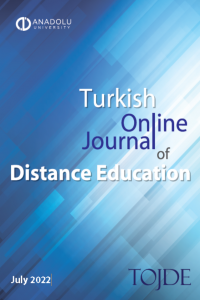Abstract
References
- Aboyinga, J., & Nyaaba, M. (2020). Factors that ensure motivation in virtual learning among college of education students in Ghana: The emergency remote teaching (ERT) during Covid’19 pandemic. European Journal of Research and Reflection in Educational Sciences Vol, 8(9), 1-9.
- Aydin, S., & Ozkul, A. E. (2015). Veri madenciligi ve Anadolu Universitesi acikogretim sisteminde bir uygulama. Egitim ve Ogretim Arastirmalari Dergisi, 4(2), 36–44.
- Bahceci, F. (2015). Ogrenme yonetim sistemlerinde kullanilan ogrenme analitikleri araclarinin incelenmesi. Turkish Journal of Educational Studies, 2(1), 41–58.
- Balyen, L., & Peto, T. (2019). Promising artificial intelligence-machine learning-deep learning algorithms in ophthalmology. The Asia-Pacific Journal of Ophthalmology, 8(3), 264-272.
- Bi, Q., Goodman, K. E., Kaminsky, J., & Lessler, J. (2019). What is machine learning? A primer for the epidemiologist. American Journal of Epidemiology, 188(12), 2222-2239.
- Brutus, S., Aguinis, H., & Wassmer, U. (2013). Self-reported limitations and future directions in scholarly reports: Analysis and recommendations. Journal of Management, 39(1), 48-75.
- Bulca, Y., & Demirhan, G. (2020). Egitsel cevrimici sosyal ogrenme ortami EDMODO’nun fiziksel aktivite kavramini ogrenmede erisiye ve kaliciliga etkisi. Egitim Teknolojisi Kuram ve Uygulama, 10(2), 577–589. doi:10.17943/etku.721876
CLASSIFICATION OF STUDENTS’ ACHIEVEMENT VIA MACHINE LEARNING BY USING SYSTEM LOGS IN LEARNING MANAGEMENT SYSTEM
Abstract
During emergency remote teaching (ERT) process, factors affecting the achievement of students have changed. The purposes of this study are to determine the variables that affect the classification of students according to their course achievements in ERT during the pandemic process and to examine the classification performance of machine learning techniques. For these purposes, the logs from the learning management system were used. In the study, analyzes were carried out with various machine learning techniques and their performances were compared. As a result of the study, it was observed that Fisher’s Linear Discriminant Analysis was the best technique in classification according to F measure performance criteria. As another result, the most effective variable, in classifying students, is the average number of days logged into the system per month and week. It has been observed that total activity duration (min), total number of weeks and total number of page views during the semester are less influential factors. Accordingly, it could be suggested to check the monthly and weekly follow-up of the lectures instead of the total follow-ups per semester. In addition, students’ interaction patterns can be monitored with course tracking systems.
Keywords
Emergency remote teaching linear discriminant analysis machine learning measurement and assessment pandemic process COVID-19.
References
- Aboyinga, J., & Nyaaba, M. (2020). Factors that ensure motivation in virtual learning among college of education students in Ghana: The emergency remote teaching (ERT) during Covid’19 pandemic. European Journal of Research and Reflection in Educational Sciences Vol, 8(9), 1-9.
- Aydin, S., & Ozkul, A. E. (2015). Veri madenciligi ve Anadolu Universitesi acikogretim sisteminde bir uygulama. Egitim ve Ogretim Arastirmalari Dergisi, 4(2), 36–44.
- Bahceci, F. (2015). Ogrenme yonetim sistemlerinde kullanilan ogrenme analitikleri araclarinin incelenmesi. Turkish Journal of Educational Studies, 2(1), 41–58.
- Balyen, L., & Peto, T. (2019). Promising artificial intelligence-machine learning-deep learning algorithms in ophthalmology. The Asia-Pacific Journal of Ophthalmology, 8(3), 264-272.
- Bi, Q., Goodman, K. E., Kaminsky, J., & Lessler, J. (2019). What is machine learning? A primer for the epidemiologist. American Journal of Epidemiology, 188(12), 2222-2239.
- Brutus, S., Aguinis, H., & Wassmer, U. (2013). Self-reported limitations and future directions in scholarly reports: Analysis and recommendations. Journal of Management, 39(1), 48-75.
- Bulca, Y., & Demirhan, G. (2020). Egitsel cevrimici sosyal ogrenme ortami EDMODO’nun fiziksel aktivite kavramini ogrenmede erisiye ve kaliciliga etkisi. Egitim Teknolojisi Kuram ve Uygulama, 10(2), 577–589. doi:10.17943/etku.721876
Details
| Primary Language | English |
|---|---|
| Journal Section | Articles |
| Authors | |
| Publication Date | July 1, 2022 |
| Submission Date | June 26, 2021 |
| Published in Issue | Year 2022 Volume: 23 Issue: 3 |


